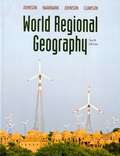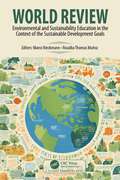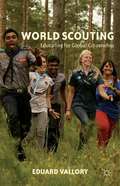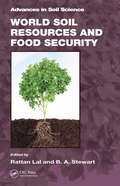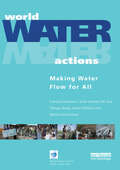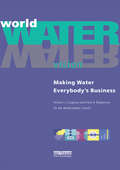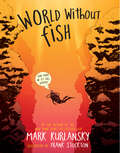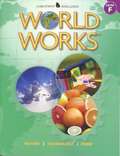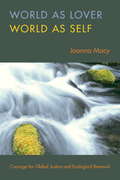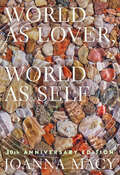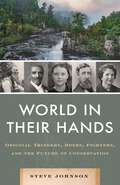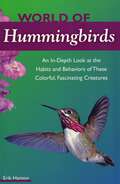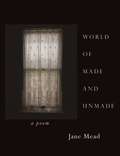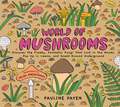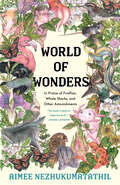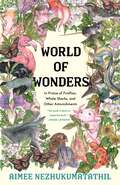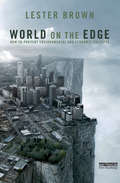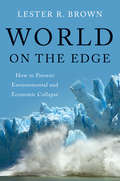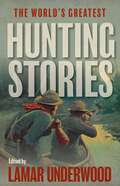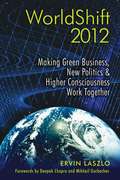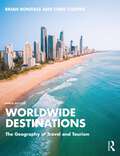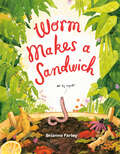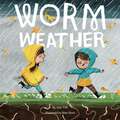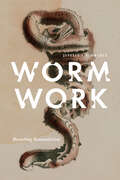- Table View
- List View
World Regional Geography (10th edition)
by David L. Clawson Merrill L. Johnson Douglas L. Johnson Viola HaarmannPulling from an impressive team of ten authors, each chapter in this book has been authored by an expert in the region to provide the utmost accuracy and relevancy. World Regional Geography explores the character of the world's people, with a central theme of human development, for an issues-oriented overview of each region. An emphasis on subregions (places within regions) enables readers to explore specific locales. An economic development theme offers a more conceptual treatment than the traditional coverage of this topic. Basic Concepts and Ideas; The United States and Canada; Latin America and the Caribbean; Europe; Northern Eurasia; Central Asia and Afghanistan; The Middle East and North Africa; Africa South of the Sahara; South Asia; East Asia; Southeast Asia; Australia, New Zealand, and the Pacific Islands. The useful references for anyone who wants to learn more about the different regions of the world.
World Review: Environmental and Sustainability Education in the Context of the Sustainable Development Goals
by Marco Rieckmann Rosalba Thomas MuñozThe global landscape of education has been reshaped by the COVID-19 pandemic, revealing the various challenges faced by countries worldwide. This book provides a comprehensive exploration of Environmental and Sustainability Education (ESE) across different countries, offering unique insights into their histories, challenges, achievements, and future ESE needs. From Africa to Oceania, the book delves into the vital role of ESE in the context of the UN Sustainable Development Goals. It highlights the diverse national discourses and the flexibility required to deliver effective global education programs. ESE practitioners, researchers, and policymakers worldwide will find inspiration and invaluable perspectives in this book.
World Scouting
by Eduard ValloryThis is the very first book to look at scouting worldwide and explain in a comprehensible way the largest youth movement on the planet, with a presence in over 165 countries on 5 continents. Based on the first academic research on world scouting, it covers the history of boy and girl scouting from its origins to the present, its structure and recognition policy, and its role in developing ideas of global citizenship and belonging. Using new data and storytelling, Eduard Vallory discusses the main elements that distinguish the scout movement all over the world; explains its origin, evolution, operating system, and values; and deals with its controversies.
World Soil Resources and Food Security (Advances in Soil Science)
by Rattan Lal B. A. StewartSoil-The Basis of All Terrestrial LifeAncient civilizations and cultures-Mayan, Aztec, Mesopotamian, Indus, and Yangtze-were built on good soils, surviving only as long as soils had the capacity to support them. In the twenty-first century, productive soil is still the engine of economic development and essential to human well-being. The quality of
World Water Actions: Making Water Flow for All
by Francois GuerquinThis text is divided into three parts. Part I focuses on the need for management to assess the challenges of water scarcity and plan changes based on proper valuation and financial instruments, international co-operation and efficient use. Part II analyses the problems of water scarcity and the available solutions in each main sector: water supply and sanitation, energy, health, agriculture, ecosystems and biodiversity. Part III assesses the state of the debate following the third World Water Forum and sets out the priorities for action, including increased investment, institutional reform and capacity building in the water sector. Downloadable resources with extensive case studies and statistical data accompanies this text.
World Water Vision: Making Water Everybody's Business
by William J. Cosgrove Frank R. RijsbermanMore than a billion people cannot get safe drinking water; half the world's population does not have adequate sanitation; within a generation over three billion will be suffering from water stress. This text analyzes the issues in this crisis of management and shows how water can be used effectively and productively. The key to sustainable water resources is an integrated approach. The authors assert that careful planning and concerted action can make the fundamental changes needed and that the implications of not dealing with the crisis are immense. The book comes with a CD ROM containing background research and scenarios.
World Without Fish
by Frank Stockton Mark Kurlansky"Can you imagine a world without fish? It's not as crazy as it sounds. But if we keep doing things the way we've been doing things, fish could become extinct within fifty years. So let's change the way we do things!" Announcing the paperback edition of World Without Fish, the uniquely illustrated narrative nonfiction account—for kids—of what is happening to the world’s oceans and what they can do about it. Written by Mark Kurlansky, the bestselling author of Cod, Salt, The Big Oyster, and many other books, World Without Fish has been praised as “urgent” (Publishers Weekly) and “a wonderfully fast-paced and engaging primer on the key questions surrounding fish and the sea” (Paul Greenberg, author of Four Fish).?It has also been included in the New York State Expeditionary Learning English Language Arts Curriculum. Written by a master storyteller, World Without Fish connects all the dots—biology, economics, evolution, politics, climate, history, culture, food, and nutrition—in a way that kids can really understand. It describes how the fish we most commonly eat, including tuna, salmon, cod, swordfish—even anchovies— could disappear within fifty years, and the domino effect it would have: the oceans teeming with jellyfish and turning pinkish orange from algal blooms, the seabirds disappearing, then reptiles, then mammals. It describes the back-and-forth dynamic of fishermen, who are the original environmentalists, and scientists, who not that long ago considered fish an endless resource. It explains why fish farming is not the answer—and why sustainable fishing is, and how to help return the oceans to their natural ecological balance. Interwoven with the book is a twelve-page full-color graphic novel. Each beautifully illustrated chapter opener links to the next to form a larger fictional story that perfectly complements the text.
World Works, Level F: Nature, Technology, Food
by McGraw-HillExplore how things work through high-interest, engaging informational nonfiction!Improve reading comprehension of informational nonfiction, encourage student inquiry with high-interest topics, and prepare students for high-stakes assessments with the World WorksTM series from Jamestown Education. World WorksTM brings the world to life. Each four-color, consumable book of the 6-book series features 9 informational articles focused on how things work. Each unit within a book covers one of the following topics; Everyday Things, Law, Health, Food, Technology, or Nature. All categories are covered at each reading level. Each article answers the question, "How Does it Work?" Each informational article includes a graph, chart, or diagram, along with an after-reading critical-thinking questions on interpreting charts and graphs.
World as Lover, World as Self
by Joanna MacyA new beginning for the environment must start with a new spiritual outlook. In this book, author Joanna Macy offers concrete suggestions for just that, showing how each of us can change the attitudes that continue to threaten our environment. Using the Buddha's teachings on Paticca Samuppada, which stresses the interconnectedness of all things in the world and suggests that any one action affects all things, Macy describes how decades of ignoring this principle has resulted in a self-centeredness that has devastated the environment. Humans, Macy implores, must acknowledge and understand their connectedness to their world and begin to move toward a more focused effort to save it.
World as Lover, World as Self: A Guide to Living Fully in Turbulent times
by Joanna MacyThis overview of Joanna Macy's innovative work combines deep ecology, general systems theory, and the Buddha's teachings on interdependent co-arising. A blueprint for social change, World as Lover, World as Self shows how we can reverse the destructive attitudes that threaten our world, with concrete suggestions on how to address "An Inconvenient Truth".The essays are based on the Buddha's teachings of "Paticca samuppada" (interdependent co-arising). Reduced to deceptively simple terms this says that everything in the world- every object, feeling, emotion, and action is influenced by a huge, all-inclusive web of factors. Any change in the condition of any one thing in this web affects everything else by virtue of interconnectedness. It makes World as Lover World as Self a quintessential guide for those readers who want to integrate their Buddhist practice with concerns for social issues like global warming. It also breaches the dualities that have haunted much of both Eastern and Western thought, namely the dichotomies between mind/body, humanity/nature, reason/emotion, self/world, science/spirituality.The premise is that self-centeredness, and modern individualisms are ultimately destructive for the environment. We are not individuals separate from the world. Instead we are always "co-arising" or co-creating the world, and we cannot escape the consequence of what we do to the environment. Joanna Macy presents a re-focusing on the beauty of the natural world as personally nourishing and replenishment as one way to move away from our self-centeredness. For this revised edition the author will be adding some chapters as well as removing others. The new ones will deal largely with her new work around the "Great Turning" that will add a somewhat more visionary, future-oriented, and strategic dimension to the book. World as Lover, World as Self shows us how to realize that the earth is an extension of ourselves and how to discover the knowledge, authority and courage to respond creatively to the crises of our time. Foreword Thich Nhat Hanh
World as Lover, World as Self: Courage for Global Justice and Planetary Renewal
by Joanna MacyThis overview of Joanna Macy's innovative work combines deep ecology, general systems theory, and the Buddha's teachings on interdependent co-arising. A blueprint for social change, World as Lover, World as Self shows how we can reverse the destructive attitudes that threaten our world, with concrete suggestions on how to address "An Inconvenient Truth".The essays are based on the Buddha's teachings of "Paticca samuppada" (interdependent co-arising). Reduced to deceptively simple terms this says that everything in the world- every object, feeling, emotion, and action is influenced by a huge, all-inclusive web of factors. Any change in the condition of any one thing in this web affects everything else by virtue of interconnectedness. It makes World as Lover World as Self a quintessential guide for those readers who want to integrate their Buddhist practice with concerns for social issues like global warming. It also breaches the dualities that have haunted much of both Eastern and Western thought, namely the dichotomies between mind/body, humanity/nature, reason/emotion, self/world, science/spirituality.The premise is that self-centeredness, and modern individualisms are ultimately destructive for the environment. We are not individuals separate from the world. Instead we are always "co-arising" or co-creating the world, and we cannot escape the consequence of what we do to the environment. Joanna Macy presents a re-focusing on the beauty of the natural world as personally nourishing and replenishment as one way to move away from our self-centeredness. For this revised edition the author will be adding some chapters as well as removing others. The new ones will deal largely with her new work around the "Great Turning" that will add a somewhat more visionary, future-oriented, and strategic dimension to the book. World as Lover, World as Self shows us how to realize that the earth is an extension of ourselves and how to discover the knowledge, authority and courage to respond creatively to the crises of our time. Foreword Thich Nhat Hanh
World in their Hands: Original Thinkers, Doers, Fighters, and the Future of Conservation
by Steve JohnsonEarth visionaries. Climate drivers. Believers. World in their Hands tells the stories of those who saw the importance of our natural world and dedicated their lives to its conservation, preservation, and protection in diverse and inspiring ways. These were tireless champions—thinkers, doers, and fighters who spoke up and took action long before it was fashionable, or critical.Thinkers such as Henry David Thoreau and Aldo Leopold ground us in their deeply rooted emotional and physical attachments to nature. Doers like Theodore Roosevelt, John Muir, and Rachel Carson include those who geared up and went out there to study, learn, record, report, and otherwise inspire the rest of the world. Fighters are the folks that got vocal, sometimes loudly, and stood their ground in the face of staunch adversity and resistance. Even at their own peril, they refused to abandon their commitment to saving a species or coveted piece of land. Taking the preservation of the natural world into their own hands, their efforts led to the founding of the National Park Service and the Wilderness Society, the establishment of the Wilderness Act, the preservation of untold millions of acres of land around the world, and countless other victories. Their inspiring stories evoke a deeper appreciation of nature in each of us; showing us where we&’ve been, how far we&’ve come, and what the road ahead will look like for the next generation of conservation crusaders, at a time when conservation, environmentalism, and action is more vital than ever.
World of Hummingbirds
by Erik M. HansonEngaging natural history information for a general audience on one of the most beloved groups of birds, including tips on attracting and watching hummingbirds. Stunning photographs of common North American and exotic world species. Explains the details of the tiny hummingbird's amazing twice-yearly migration.
World of Made and Unmade
by Jane MeadMead's fifth collection candidly and openly explores the long process that is death. These resonant poems discover what it means to live, die, and come home again. We're drawn in by sorrow and grief, but also the joys of celebrating a long life and how simple it is to find laughter and light in the quietest and darkest of moments.
World of Mushrooms: Discover the Freaky, Fantastic Fungi That Lurk in the Woods, Pop Up in Lawns, and Sneak Around Underground
by Pauline PayenGet a close-up look at twenty common mushrooms and their habitats in this lively introduction to the kingdom of fungi. Explore different mushroom habitats and discover how they communicate with other organisms in this charmingly illustrated guide. Featuring profiles of different mushrooms—from chanterelles and oyster mushrooms to stinkhorns, penny buns, amanitas, and more—this engaging science and nature book brings mushrooms to life for readers ages 7 to 11. With World of Mushrooms, readers will: ·Observe common mushrooms up close. ·Learn how mushrooms communicate. ·Find out how and where mushrooms grow. ·Spot mushrooms in the wild.
World of Wonders: In Praise of Fireflies, Whale Sharks, and Other Astonishments
by Aimee Nezhukumatathil“A poet celebrates the wonders of nature in a collection of essays that could almost serve as a coming-of-age memoir.” —Kirkus ReviewsAs a child, Nezhukumatathil called many places home: the grounds of a Kansas mental institution, where her Filipina mother was a doctor; the open skies and tall mountains of Arizona, where she hiked with her Indian father; and the chillier climes of western New York and Ohio. But no matter where she was transplanted—no matter how awkward the fit or forbidding the landscape—she was able to turn to our world’s fierce and funny creatures for guidance.“What the peacock can do,” she tells us, “is remind you of a home you will run away from and run back to all your life.” The axolotl teaches us to smile, even in the face of unkindness; the touch-me-not plant shows us how to shake off unwanted advances; the narwhal demonstrates how to survive in hostile environments. Even in the strange and the unlovely, Nezhukumatathil finds beauty and kinship. For it is this way with wonder: it requires that we are curious enough to look past the distractions in order to fully appreciate the world’s gifts.Warm, lyrical, and gorgeously illustrated by Fumi Nakamura, World of Wonders is a book of sustenance and joy.Praise for World of WondersBarnes & Noble 2020 Book of the YearAn NPR Best Book of 2020An Esquire Best Book of 2020A Publishers Weekly “Big Indie Book of Fall 2020”A BuzzFeed Best Book of Fall 2020“Hands-down one of the most beautiful books of the year.” —NPR“A timely story about love, identity and belonging.” —New York Times Book Review“A truly wonderous essay collection.” —Roxane Gay, The Audacity
World of Wonders: In Praise of Fireflies, Whale Sharks, and other Astonishments
by Aimee NezhukumatathilFrom beloved, award-winning poet Aimee Nezhukumatathil comes a debut work of nonfiction-a collection of essays about the natural world, and the way its inhabitants can teach, support, and inspire us.
World on the Edge: How to Prevent Environmental and Economic Collapse
by Lester BrownIn this urgent time, World on the Edge calls out the pivotal environmental issues and how to solve them now. We are in a race between political and natural tipping points. Can we close coal-fired power plants fast enough to save the Greenland ice sheet and avoid catastrophic sea level rise? Can we raise water productivity fast enough to halt the depletion of aquifers and avoid water-driven food shortages? Can we cope with peak water and peak oil at the same time? These are some of the issues Lester R. Brown skilfully distils in World on the Edge. Bringing decades of research and analysis into play, he provides the responses needed to reclaim our future.
World on the Edge: How to Prevent Environmental and Economic Collapse
by Lester R. BrownIn this urgent time, World on the Edge calls out the pivotal environmental issues and how to solve them now. We are in a race between political and natural tipping points. Can we close coal-fired power plants fast enough to save the Greenland ice sheet and avoid catastrophic sea level rise? Can we raise water productivity fast enough to halt the depletion of aquifers and avoid water-driven food shortages? Can we cope with peak water and peak oil at the same time? These are some of the issues Lester R. Brown skillfully distills in World on the Edge. Bringing decades of research and analysis into play, he provides the responses needed to reclaim our future.
World's Greatest Hunting Stories
by Edited by Lamar UnderwoodAs William Faulkner has so eloquently written, &“The past is never dead. It&’s not even past.&” In this collection, hunting stories by distinguished writers bring to printed pages the days afield they enjoyed in world-wide locations in days long past. Prose vivid and timeless captures the drama and emotions experienced in hunts for deer, as well as big game and birds in locations ranging from the Rocky Mountains to Britian&’s moors to African plains. These are enduring tales that have passed the test of time and have attracted generations of readers. From moments of great danger to campsite bliss, the stories have the intensity of real life.
WorldShift 2012: Making Green Business, New Politics, and Higher Consciousness Work Together
by Deepak Chopra Ervin Laszlo Mikhail GorbachevA handbook for conscious change that could transform the current world crisis into planetary renewal • Outlines the problems that make today’s world prone to breakdown and suggests actions we must adopt in politics, business, and everyday life • Replaces the limited consciousness of our failing society with the holistic consciousness that is rooted in the Akashic field The deepening economic crisis and the threat posed by climate change and other social and ecological trends has caused many to despair. But with great danger comes great opportunity--the opportunity for fundamental change that will transform our societies from top to bottom. In WorldShift 2012, Ervin Laszlo brings together insights for creating sustainable positive change from spiritual leaders, scientists, and visionary businesspeople--people such as Albert Einstein, Mohammad Yunus, Václav Havel, Eckhart Tolle, Ken Wilber, David Korten, Paul Hawken, and Tomoyo Nonaka, former CEO of Sanyo Electronics. He shows how we can replace the limited consciousness of our failing society with the holistic consciousness that is reflected in the unified field of quantum physics: the Akashic field. We have an opportunity to move from the current political and business model of grow or die to a sustainable world respectful of human beings, nature, and the planet. Change on this level calls for a profound shift in consciousness and a clear understanding that--as cutting-edge physics shows--we are truly connected with each other and with the cosmos. This book presents clear evidence of this connectedness and describes the tools we need to make our world greener and our planet safer as we strive to realize the holistic consciousness of connection through the Akashic field.
Worldwide Destinations: The Geography of Travel and Tourism
by Chris Cooper Brian BonifaceWorldwide Destinations: The Geography of Travel and Tourism is a unique text that explores tourism demand, supply, organisation, and resources for every country worldwide in a logically structured and accessible format.The ninth edition is fully updated to include the following features: Greater exploration of current issues such as climate change, the impact of COVID-19 on destinations and subsequent recovery strategies, regenerative tourism, changes in consumer behaviour, and sustainability New and updated case studies throughout Increased emphasis on South America and a new chapter focussing on the tourism geography of Antarctica Enhanced online resources for lecturers and students including PPTs, web links, video links, MCQs, and discussion questions The first part of this book comprises thematic chapters that detail the geographic knowledge and principles required to analyse the tourism appeal of destinations. The subsequent division of this book into regional chapters enables the student to carry out a systematic analysis of a particular destination by providing insights on cultural characteristics as well as information on specific places.This volume is an invaluable resource for studying every destination in the world, explaining tourism demand, evaluating the many types of tourist attractions, and examining the trends that may shape the future geography of tourism. This thorough guide is a must-have for any student undertaking a course in travel and tourism.
Worm Makes a Sandwich
by Brianne FarleyA sweetly humorous picture book about composting, told from the point of view of a worm.Meet Worm. He might be little. He might have no hands. But Worm would love to make a sandwich, just for you! To get started he'll need just one thing: garbage! Delicious, delectable garbage like apple cores and mushy grapes, broccoli bottoms and carrot tops, sad celery, and drippy cucumbers. Worm and his friends eat the garbage. And then they do what everyone does after they eat garbage. They poop! The poop goes in the compost and the compost goes in your garden, which is where the vegetables for your sandwich come from!Simple, right? Worm thought you'd agree. He might just need a bit of assistance along the way . . .This hilarious, engaging picture book is the perfect introduction to the process of composting from start to finish, told from the perspective of one little worm who is very eager to help.
Worm Weather (Penguin Core Concepts)
by Jean TaftDrip,drop,skip and hop.Splish, splash,sidewalk dash!It's worm weather! Join in the rainy-day fun, as kids splash through the puddles, affecting another weather enthusiast, a nearby worm. An imaginative and playful story, readers will love seeing the worm delight in the weather just as much as the kids.Worm Weather covers the concepts of Imagination and Weather.
Worm Work: Recasting Romanticism
by Janelle A. SchwartzWorms. Natural history is riddled with them. Literature is crawling with them. From antiquity to today, the ubiquitous and multiform worm provokes an immediate discomfort and unconscious distancing: it remains us against them in anthropocentric anxiety. So there is always something muddled, or dirty, or even offensive when talking about worms. Rehabilitating the lowly worm into a powerful aesthetic trope, Janelle A. Schwartz proposes a new framework for understanding such a strangely animate nature. Worms, she declares, are the very matter with which the Romantics rethought the relationship between a material world in constant flux and the human mind working to understand it.Worm Work studies the lesser-known natural historical records of Abraham Trembley and his contemporaries and the familiar works of Erasmus Darwin, Charles Darwin, William Blake, Mary Shelley, and John Keats, to expose the worm as an organism that is not only reviled as a taxonomic terror but revered as a sign of great order in nature as well as narrative. This book traces a pattern of cultural production, a vermiculture that is as transformative of matter as it is of mind. It distinguishes decay or division as positive processes in Romantic era writings, compounded by generation or renewal and used to represent the biocentric, complex structuring of organicism.Offering the worm as an archetypal figure through which to recast the evolution of a literary order alongside questions of taxonomy from 1740 to 1820 and on, Schwartz unearths Romanticism as a rich humus of natural historical investigation and literary creation.
